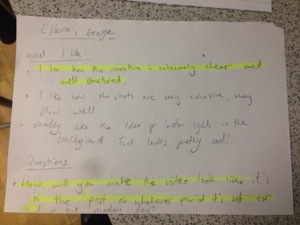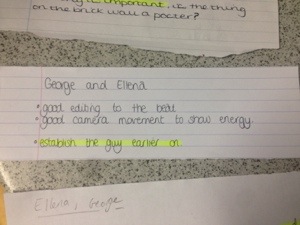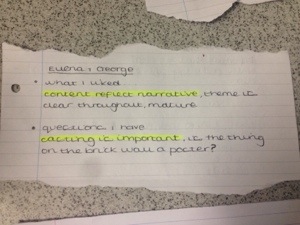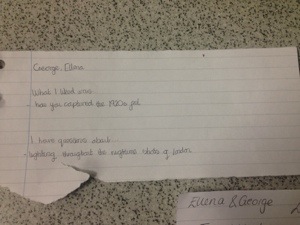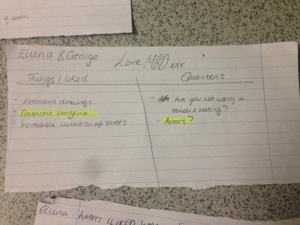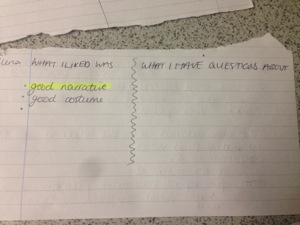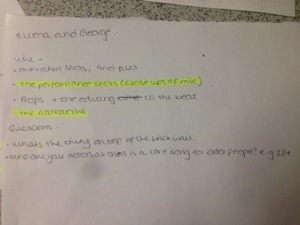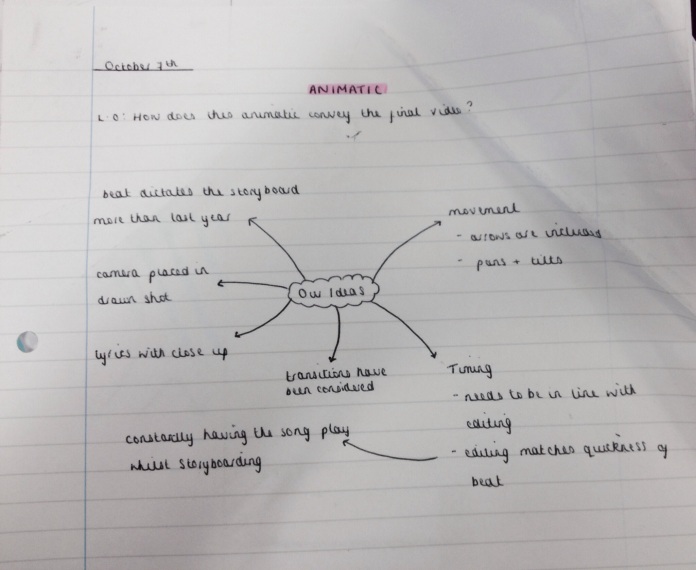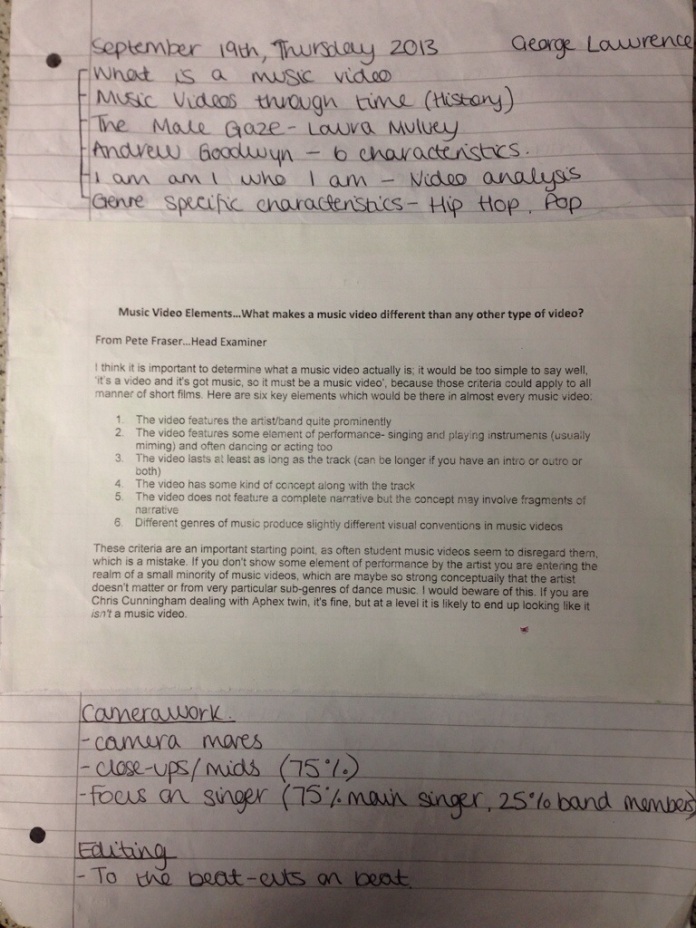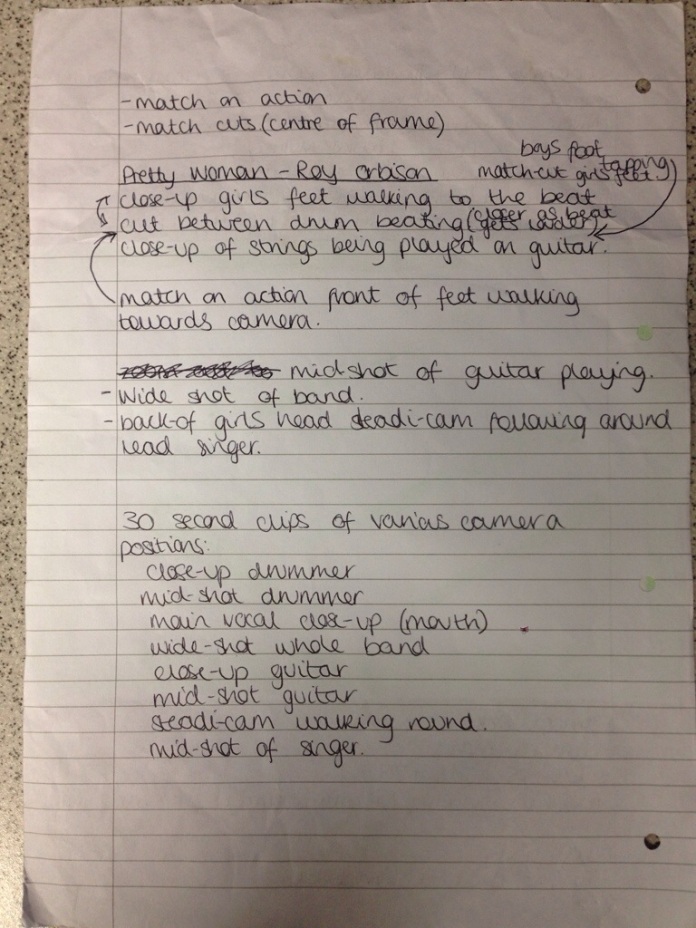We are currently preparation to travel to our first location (London) to shoot these specific shots in our animatic. We are having to remember to take these vital items
– storyboard used for the animatic > this is a necessity as we are using a colour coordinated version to be able to quickly specify what shots we need in that particular location, helping us control time management
– steadicam > absolutely vital for the tracking shots of the artist, as we have practised in our previous blog post, and have found the steadicam produces an extremely more smoother and stable finish to the moving shots
– Camera with strap for adaptability
– Props + Costume accessories > this is only really the artists jewellery and the males hat.
Category Archives: Storyboarding/ Scripts
Treatment Presentation
Once we produced our treatment, we were given the task of presenting our ideas to the class and had to answer any questions and gain feedback that they had. This video was shot about a month ago, however, was only recently available to us. To see our original ‘Treatment’ blog post click here.
Additional feedback on our Animatic
Mr Gilbert has given us the following feedback on our animatic:
George and Ellena: I liked the whole ambience of the video and the way in which the mis-en-scene, lighting and character combine. The variety of camera shots is impressive. Perhaps you could add a more narrative interest into the video, tell a bit more of a story?? The focus in your video is very much on the singer and the mis-en-scene which puts a lot of pressure on this area. Considering how you might develop a story, or a montage series of scenes which are inter-spliced with the singer might give you more room for manoeuvre. Basically, just trying to develop a bit more of an imaginative response to the song is something to consider, which you may reject, but at least worth considering.
Animatic Reflection
From producing the animatic, as a group, we have learnt a lot about the following aspects of our music video: Location; Mise en Scene; Editing; Camerawork and the need for good communication within the group. We found all were extremely important, however, if we were to rate these aspects in order of importance then it would be as follows:
- Camerawork
- Editing
- Communication with group members
- Mise en Scene
- Location
Camerawork, we believe, was the aspect we learnt the most about from this task. We feel this as through creating a storyboard it is necessary to carefully consider each and every individual shot that you would like to see in the video. We had to think about shot angles, movements, compositions, time periods and the subjects and so was very thorough and time consuming. One thing we will take away from this assignment is to consider how long it takes for the action in a shot to occur. We found that we were basing the shot durations on the beat of the song and gave little consideration for the time it may take for our artist to move around the shot and therefore feel we may have to lenghten certain sequences in order to keep the narrative flowing and appear to be happening in real-time.
Editing we placed as the second element that we have learnt the most about as through producing the animatic we got experience in certain softwares and learnt of the limitations that some programmes have. For the animatic we used iMovie as this is currently a relatively basic editing task but we discovered that it may be the wrong choice of editig software for our final music video as we may need a programme that is more advanced and that provides us with a wider spectrum of tools. An example of when we were limited due to the editing software was for the final 5-6 shots where there is an overlapping of the shots and cross-fade transitions. iMovie is reluctant to layer video clips unless in advanced mode and even then the programme was not responding how we would have liked and so we will have to consider our options on what other editing softwares are available for us to use.
Communication with group members we found was an equally important element when producing a music video in a group. We had to constantly stay in contact with eachother through text and emails in order to clarify times we were meeting and to catch up on the work that we had each individually been producing outisde of class. While learning of the importance of communication, we found we were communicating well and so will continue to stay in contact regularly throughout our final videos pre-production, production, and post-production.
Mise en Scene is another extremely important aspect just like the others in this list, but Mise en scene in particular as in the start of our video we aim to replicate the style of a different decade. From producing the animatic we now have a list of the props that will be in our video and so can now begin to obtain such objects that reflect the 1920’s time period. Without these props the video could look, empty tacky and irrelevant to the sound of the music and so is an extremely important aspect. Moreover, the lighting also needs to be considered as we have a clear plan of how we will light the theatre shots however, we need to seriously now consider how we will get the correct lighting for the shots outside through the London streets. Finally, the costume is an important element that needs to reflect the 1920’s time period and so we need to begin to collect such costumes affordably as well as cast actors of the appropriate age in order to make the narrative as believable and emotive as possible.
Location we listed as the element we have learnt the least about from this animatic task as we previously had ideas of where the London shots will be filmed and where the theatre scenes will be shot, we just now know that we need to take a trip into London and pin-point exactly where we will film and assess the accessibility of such locations.
Animatic Feedback
After submitting our animatic assignment we were provided with feedback from Mr Dunford (one of our media studies teachers), in the form of a SoundCloud audio clip. This feedback will be very helpful to see how people other than Ellena and I interpret our music video idea and to see whether the narrative is conveyed well. It now has also been highlighted, certain aspects such as location and casting which we can now look further into and the work that will be needed in making this idea a reality. Moving forward, we will be constantly referring back to the animatic feedback that we have received and continue to show our idea to others in order to gain as much information and ideas as possible before we solidify our video and begin filming.
If I Ain’t Got You – (Alicia Keys) Ameli Animatic
Connection to Coursework:
Whilst planning, producing and editing our animatic, we were able to produce a moving storyboard that will enable us, unlike AS, to be able to produce a shot-by-shot plan with the editing already decided and inserted into the video.
Planning
- we used our initial ideas and our existing blog posts to be able to have an outline of what we were going to produce in our animatic and the type of shots that would be included.
- we had to plan out where and how frequent we were going to meet in the next two weeks to produce the animatic, prior to making the storyboard, as we knew this was going to be a very hefty task that would require a lot of work outside of lessons.
Producing
- The main aspects in producing the animatic were- drawing the separate shots (approx.140), planning and labelling how they were going to be edited together and any camera movement that was involved, and then filming each separate shot for about 2-4 seconds in preparation to edit and export the animatic.
- In producing the animatic, we learnt how to manage our time efficiently, how to use time outside of lessons to plan our separate ideas, then come together and compromise with what was best for the music video.
- We also learnt the importance of camera movement, the 75% of the shots being of the artist, and close ups in our music video. As well being in our rules in making our music video, we learnt the significance of this because of the task of manipulating our location with our low budget. The close ups of the artist are therefore very important, yet must be varied, so we learnt how to use constant camera movement, and therefore show it in the animatic.
Editing
- We edited our animatic on an apple mac (iMovie), which allowed us to use basic software, but software that was reliable and efficient as our shots were basic, and were there to give a general overview of the kind of shots we are thinking of filming.
- Editing our music video was one of the most strenuous tasks as we wanted to get the editing perfect, and a complete match to what our final music video is going to be. It took quite a long time to film each separate box of the storyboard for 2-4 seconds, and then upload the shots together to be able to edit, crop, and pan them.
Overall, our animatic helped us to be able to produce a detailed storyboard with ideas of specific shots, and editing sequence. It also taught us how to manage our time efficiently, and how to work together to produce a lot more shots than we ever produced at AS. We can now look in detail at location scouting and costume and props, as our shots and editing are planned out shot-by-shot.
Animatic Feedback
Before our Animatic was complete, we felt it would be a good idea to gain some feedback on the shots we have produced so far and to get inspiration for future shots. We played the song while pointing towards the corresponding shot illustration in order to help show the rhythm and then asked our teacher, Mr Gilbert to provide us with feedback. We recorded his thoughts and this is what we discovered:
Animatic Task
On Monday 7th October we were set the task to complete an animatic of our full music video, including showing the movement of the camera, and unlike AS, we had to show the pace of editing and where the cuts would take place.
We will show this when we edit the animatic, either in iMovie or Final Cut Express.
In class we looked at two different animatics, one which gained nearly full marks from the exam board, which we are using as a guide when making our animatic, and one which uses the 1920’s theme, similar to our music video idea.
– http://www.youtube.com/watch?v=HHZoZ6rU_SM&safe=active
Pretty Woman Assignment Plan
Here is the plan of a short assignment we were set in class which was to produce the beginning sequence for a music video to the song ‘Pretty Woman’ by Roy Orbison.


